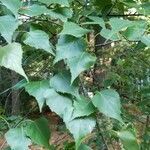Like a smaller and shorter-lived version of no. 4 [Betula papyrifera Marshall], seldom over 10 m tall, the trunks commonly clustered and erect-ascending, seldom over 1.5 dm thick; bark more dead-white with proportionately more black marking; lvs smaller, broadest near the often subtruncate base, and concavely tapering to a long, slender point, doubly serrate except on the base, glabrous beneath; fruiting catkins 1.3–3 cm; scales densely short-hairy on both sides; obtriangular in outline, 3–4.2 × 3–4.5 mm, the broad, falcate-obovate lateral lobes widely spreading, much larger than the terminal lobe and partly covering it; frs oblate, deeply retuse, broadly winged, 2.2–3 mm wide, the body 0.6–1 mm wide. Mostly diploid, 2n=28. Seral in upland woods and old fields; N.S. to s. Que., s. N.J. and Pa., with outlying stations in n. Va., s. Ont., n. O., and ne. Ind.
A tree that loses its leaves. It grows 10 m high and spreads 3 m wide. The trunk is erect and slender. The leaves are heart shaped with a long point. They are paler underneath. The flowers are catkins.


